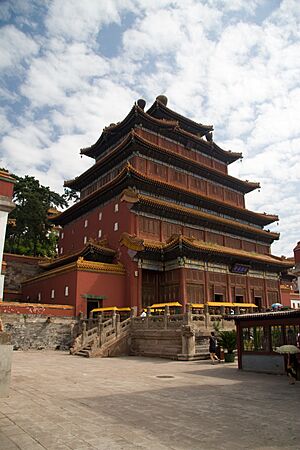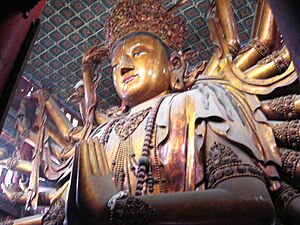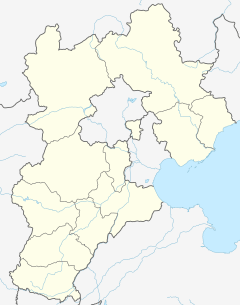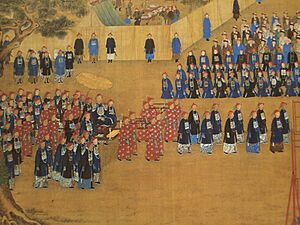Puning Temple (Hebei) facts for kids
Quick facts for kids Puning Temple |
|
|---|---|
|
普宁寺
|
|

Puning Temple
|
|
| Religion | |
| Affiliation | Buddhism |
| Sect | Tibetan Buddhism–Gelug |
| Location | |
| Location | Chengde, Hebei, China |
| Architecture | |
| Architectural style | Tibetan architecture |
| Founder | Qianlong Emperor |
| Date established | 1755 |
| Puning Temple | |||||||||
|---|---|---|---|---|---|---|---|---|---|
| Simplified Chinese | 普宁寺 | ||||||||
| Traditional Chinese | 普寧寺 | ||||||||
|
|||||||||
The Puning Temple (Chinese: 普宁寺; pinyin: Pǔníng Sì; literally "Temple of Universal Peace") is a famous Buddhist temple in Chengde, Hebei province, China. People often call it the Big Buddha Temple. It was built a long time ago in 1755. This was during the time of the Qianlong Emperor in the Qing dynasty.
The temple is close to the Chengde Mountain Resort. It is also near another well-known temple, the Putuo Zongcheng Temple. Puning Temple is one of the "Eight Outer Temples" in Chengde. These temples are very important historical sites.
The Puning Temple was designed to look like the Samye Monastery. Samye Monastery is a very special Buddhist place in Tibet. The front part of Puning Temple looks like a Chinese temple. But the rest of the temple complex mixes both Chinese and Tibetan building styles.
Puning Temple is home to the world's tallest wooden statue of a Bodhisattva named Avalokiteśvara. This huge statue is 22.28 meters (about 73 feet) tall and weighs 110 tons! That's why the temple is often called the "Big Buddha Temple." The temple complex has many cool buildings. These include temple halls, pavilions, and towers for drums and bells.
History of Puning Temple

In the 1700s, during the Qing dynasty, there was a group of people called the Dzungars. They lived in northwestern China, in an area now known as Xinjiang. The Dzungars were fighting against the Qing empire. The Qianlong Emperor sent his army to stop their resistance.
After the Qing army won, the Qianlong Emperor wrote a special message. This message was carved onto a stone tablet. You can still see this tablet in the Puning Temple today. The tablet, called the Puning Sibei, was made in 1755. It celebrates the temple's founding and the victory over the Dzungars.
The Qianlong Emperor ordered this new "Temple of Universal Peace" to be built. He wanted it to show his hope for peace among different groups of people. He also wanted a stable environment in the northwestern parts of his empire. Chengde was a very important place for the Qing rulers. It was their summer capital and a place to show their power. Since the Dzungars followed Tibetan Buddhism, the temple was built to look like the Samye Monastery in Tibet.
The Big Buddha Statue
The large wooden Buddhist statue of the Bodhisattva Avalokiteśvara is a main attraction. It is located in the temple's biggest hall. This amazing statue has a thousand different eyes and a thousand different arms. These arms stretch out from its body in many sizes. The statue itself is made from five different kinds of wood. These include pine, cypress, elm, fir, and linden wood.
World Heritage Site
In 1994, the Chengde Mountain Resort and the Eight Outer Temples were named UNESCO World Heritage Sites. This means they are very important places for everyone in the world to protect. Today, Puning Temple is still a popular place for tourists to visit. It also hosts local celebrations and events.
Gallery
-
Turning wheels of the Buddha's doctrine at Puning Temple, a modern addition.
See also
- List of Buddhist temples
- Putuo Zongcheng Temple














